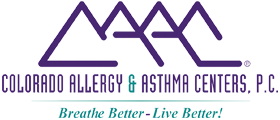Exercise-induced bronchospasm (EIB; also called exercise-induced asthma) describes the onset of respiratory symptoms including shortness of breath, chest tightness and cough with exercise. These symptoms typically begin less than 5 minutes after exercise has ended and last for up to 1 hour.
It is estimated to affect up to 20% of the general population and up to 90% of patients with asthma. Perhaps surprisingly, EIB is relatively common among elite athletes, affecting 18% of swimmers at the Beijing and Athens Olympic Games.
The mechanism behind EIB is unknown but is thought to relate to the rapid rise in the volume of cool, dry air inhaled with exercise. Thus, the cold, dry air during the colder months in Colorado is a common trigger.
In patients with environmental allergies (such as to pollens and molds) symptoms can worsen when pollen counts are high.
Diagnosis may involve procedures such as an exercise challenge or methacholine challenge, both of which are available at CAAC.
In terms of prevention, wearing a loose-fitting scarf over the mouth and nose can help warm and humidify inhaled air. Performing an indoor warm-up prior to outdoor exercise and improving overall cardiovascular fitness can also help. In select patients, limiting outdoor exercise when pollen and pollution counts are high is beneficial.
Treatment with a variety of inhaled and oral medications used preventatively and as-needed for symptom relief has also been proven to help.
Exercise is one of the best things we can do to improve our overall health and has been proven to improve asthma symptoms. It is particularly important that patients with asthma do not avoid exercise unnecessarily. If you think you are suffering from EIB please speak with your asthma specialist – we would be happy to help you enjoy the benefits of exercise!
Category: Uncategorized



